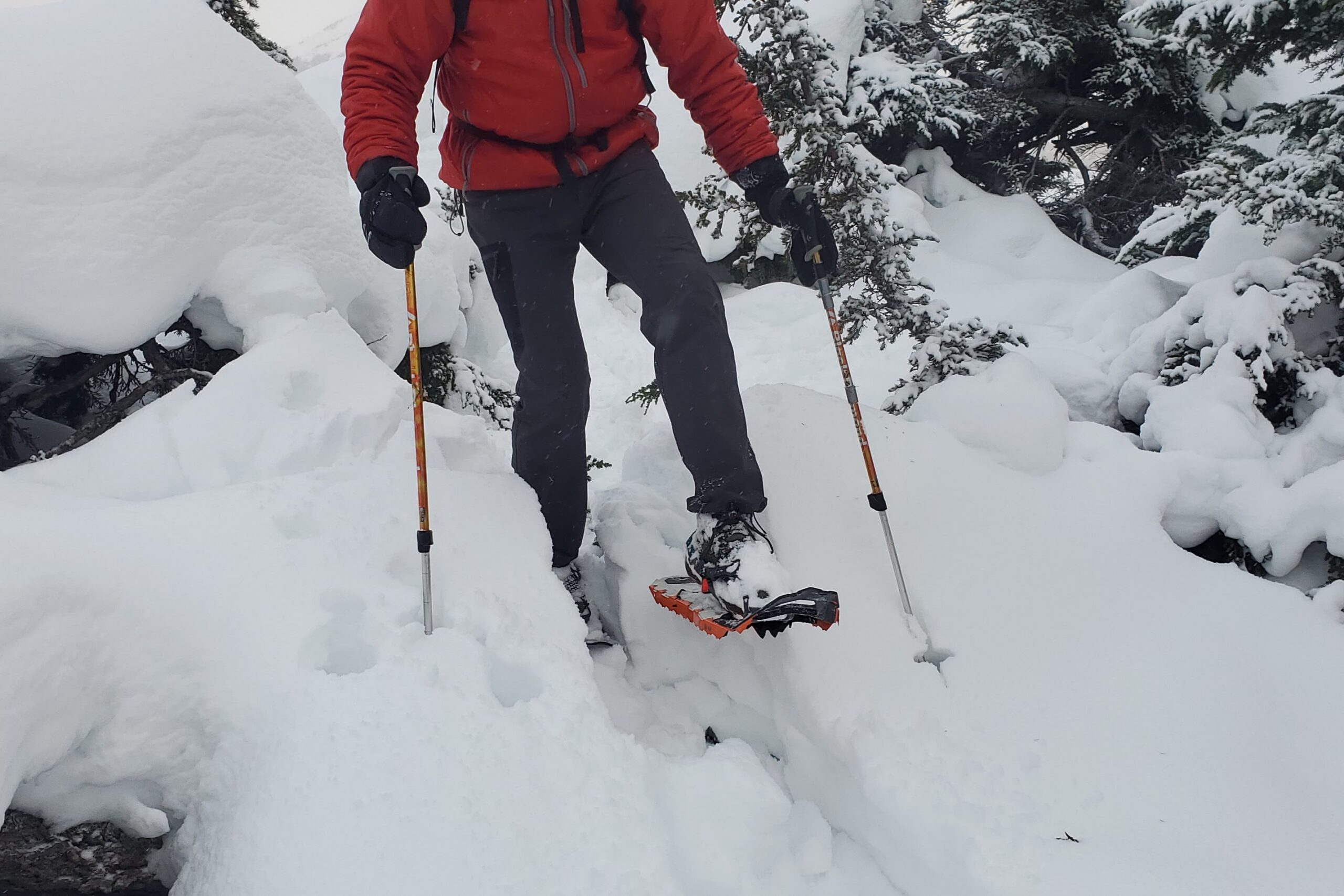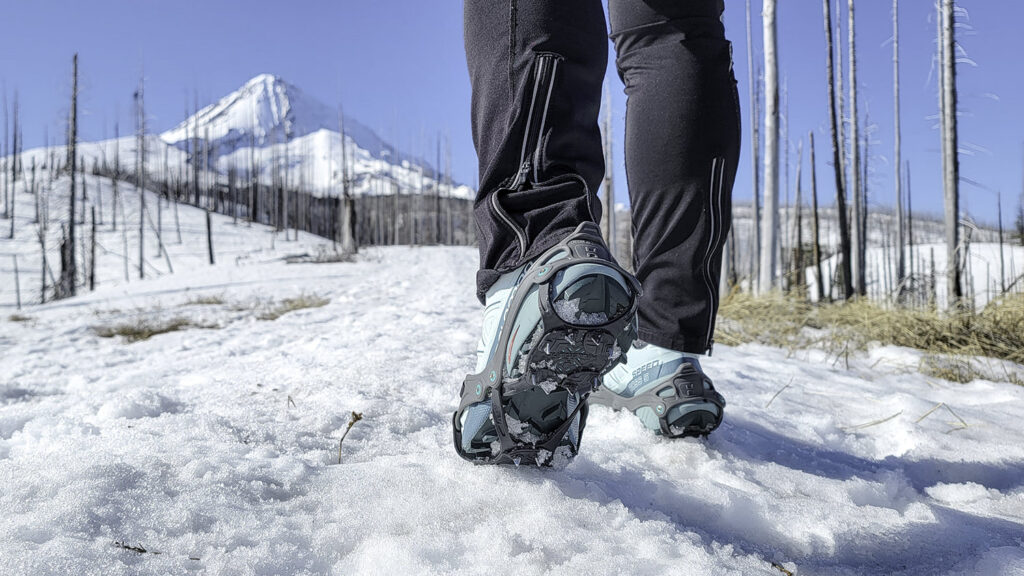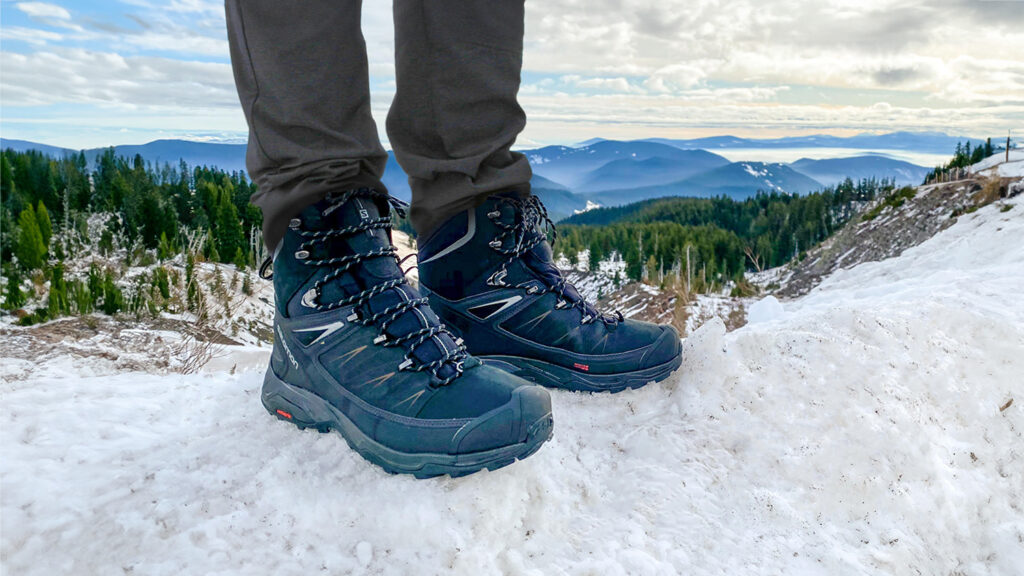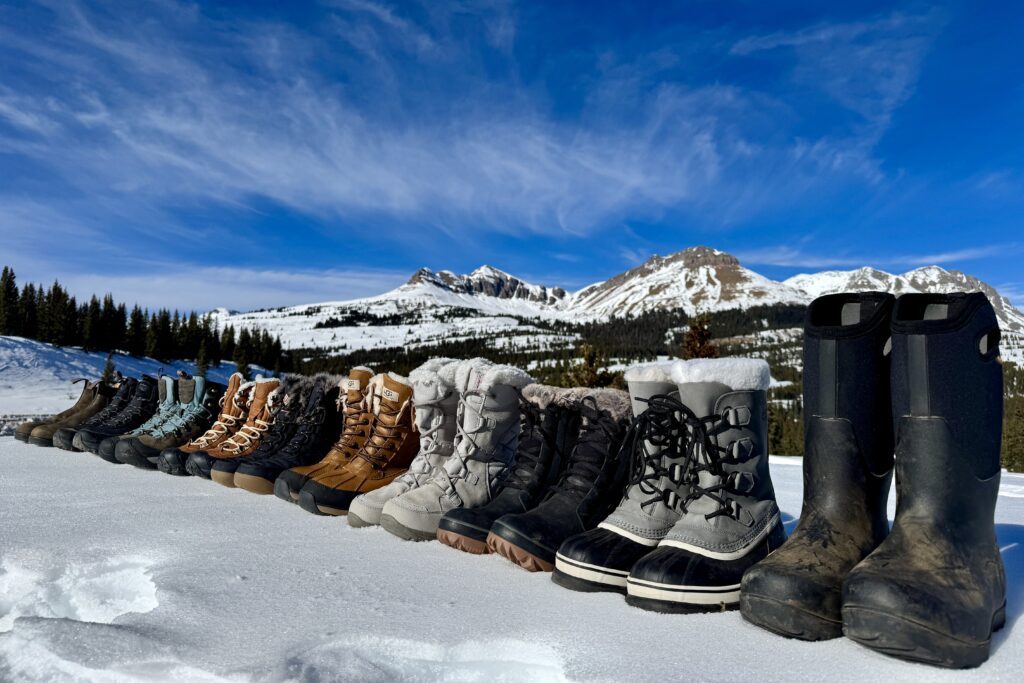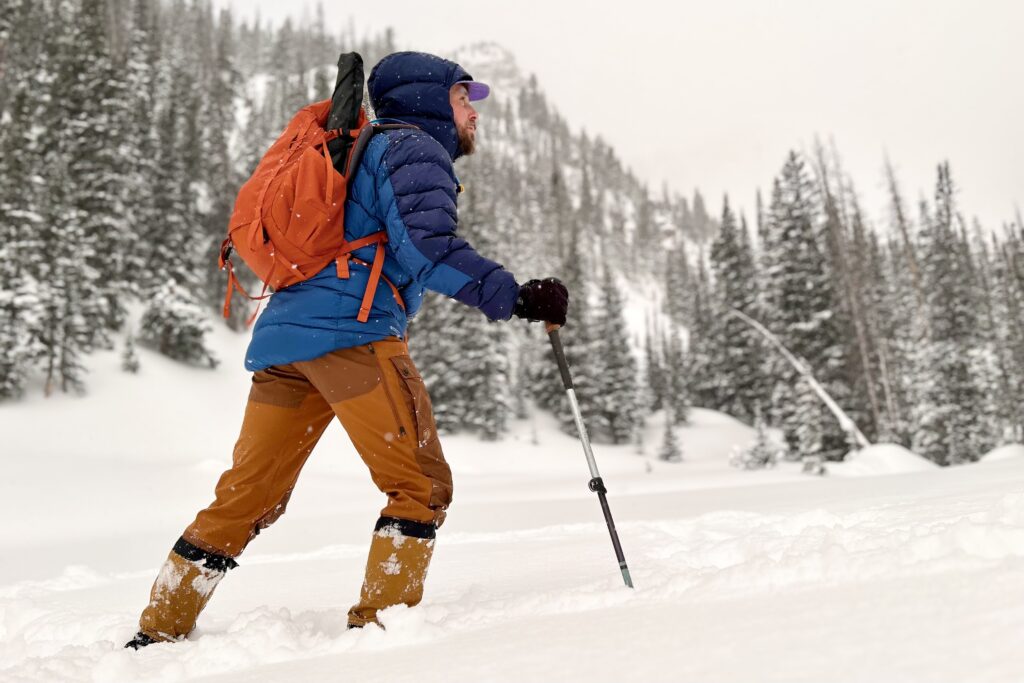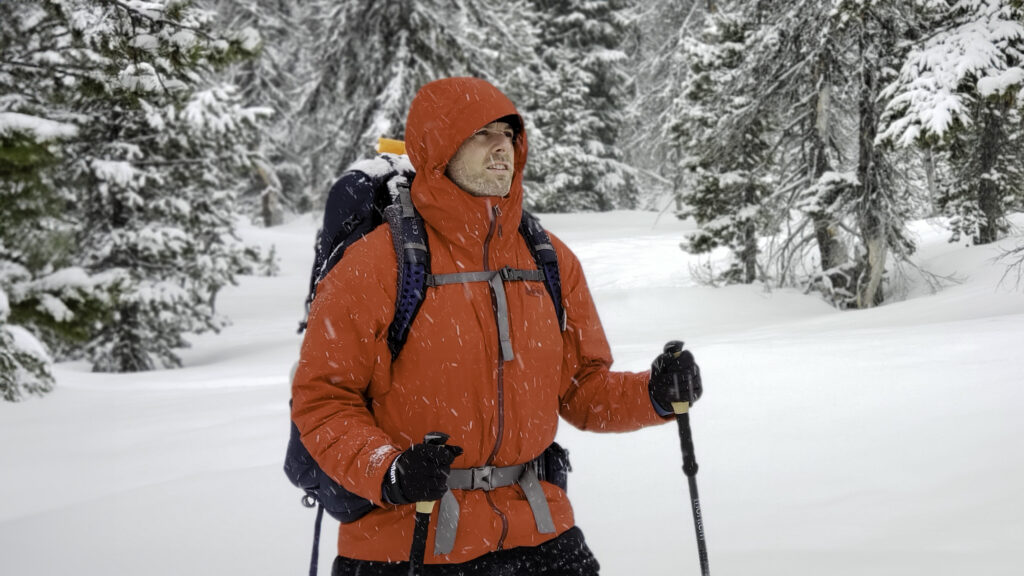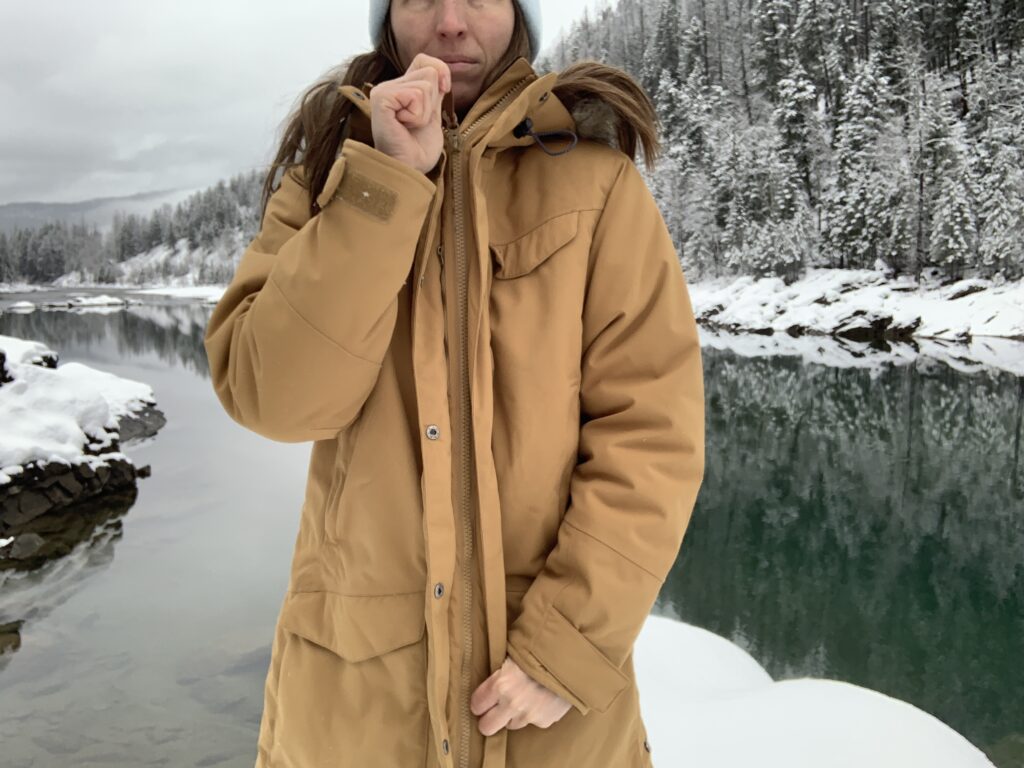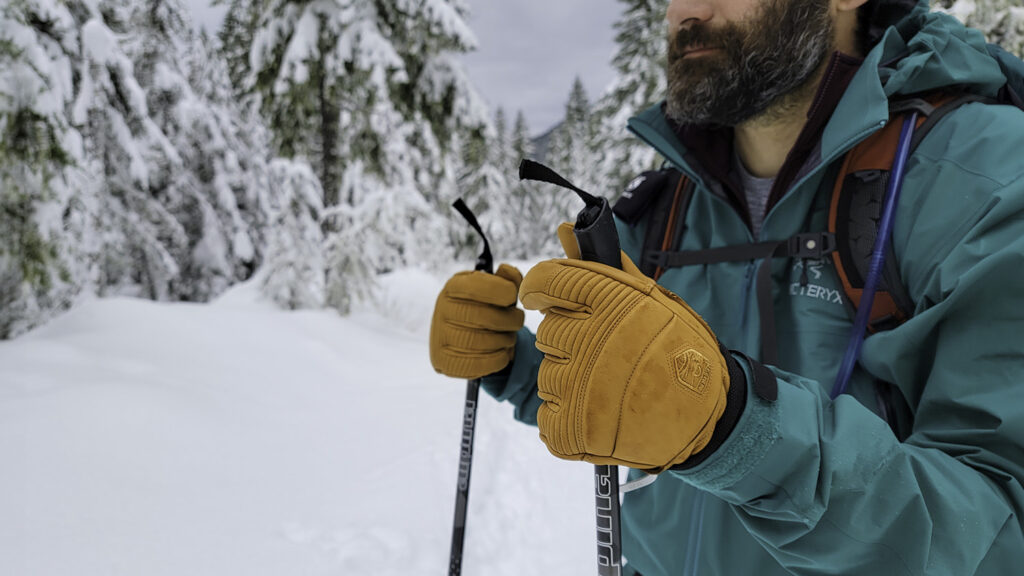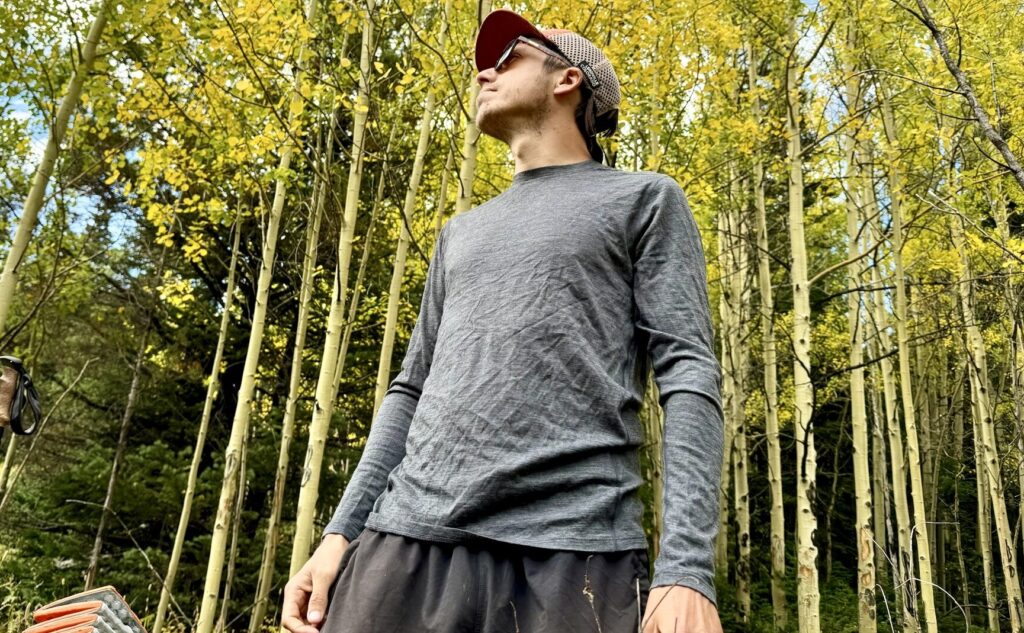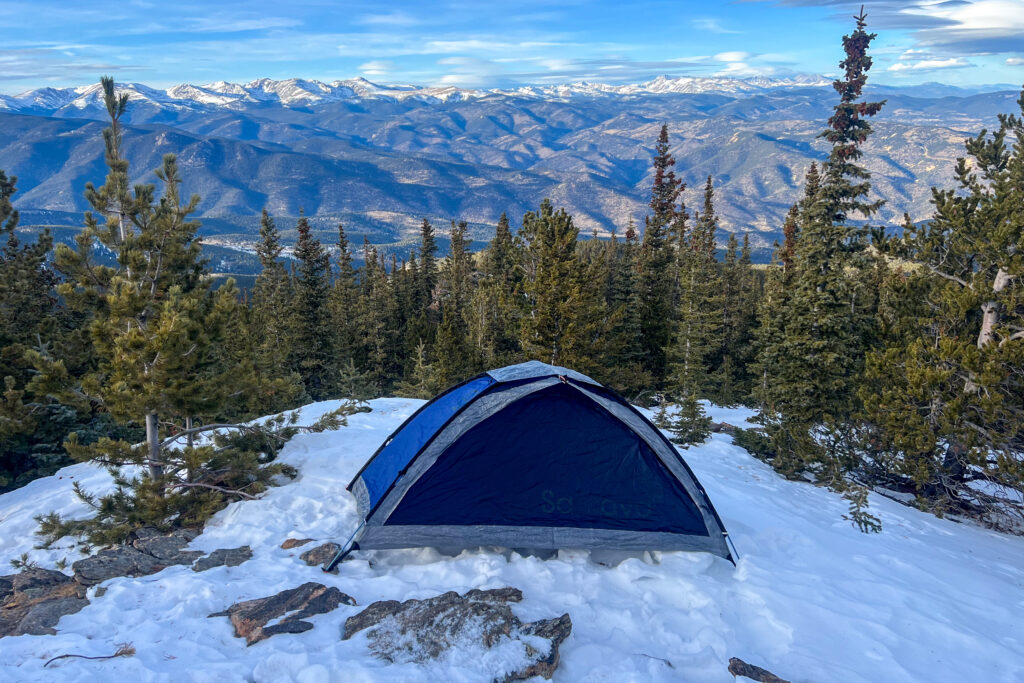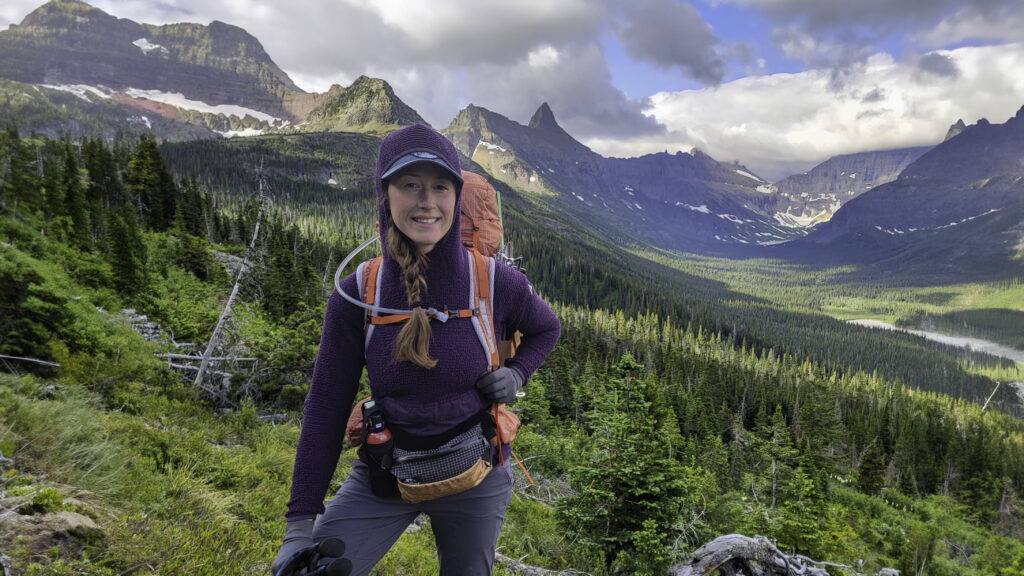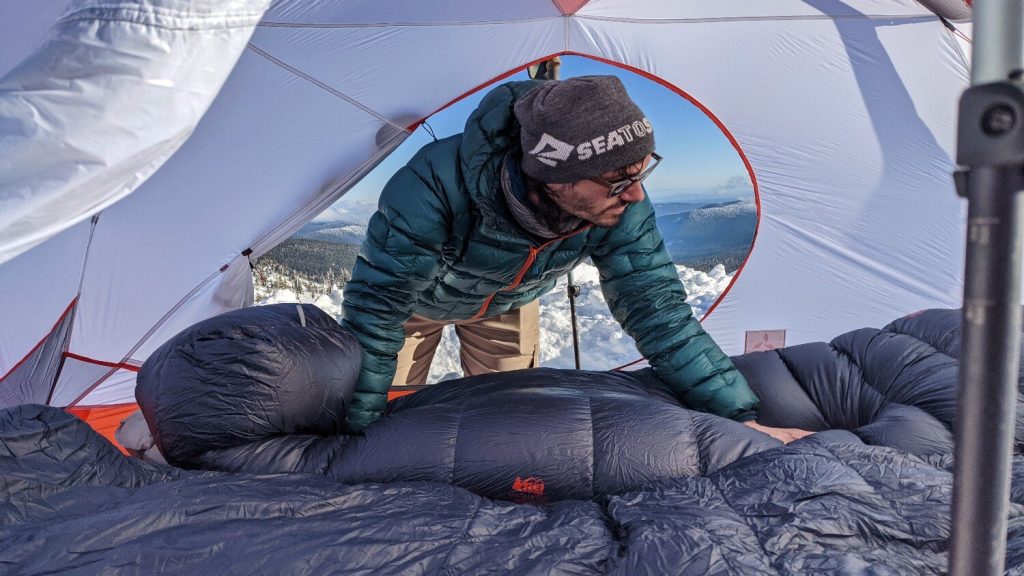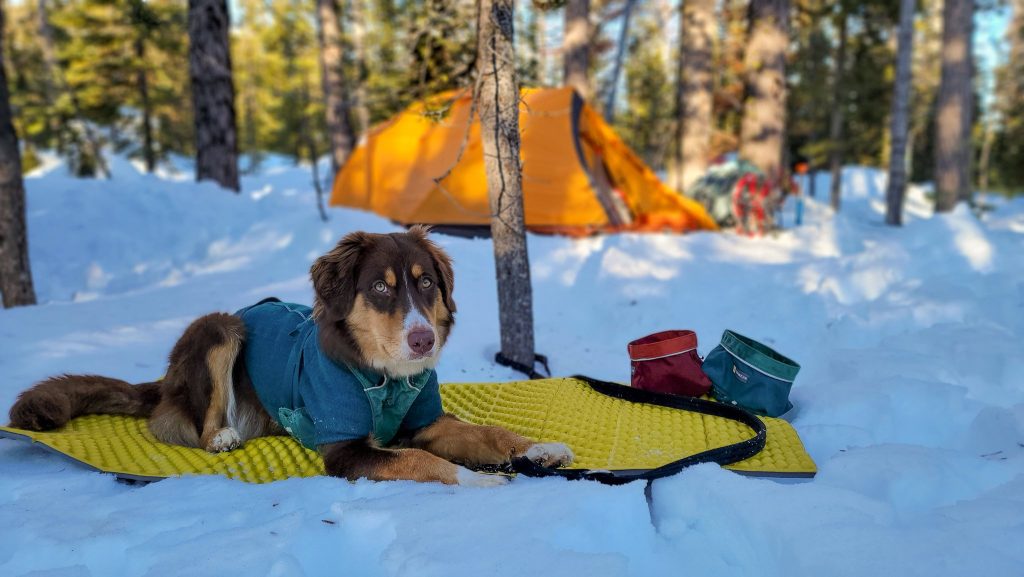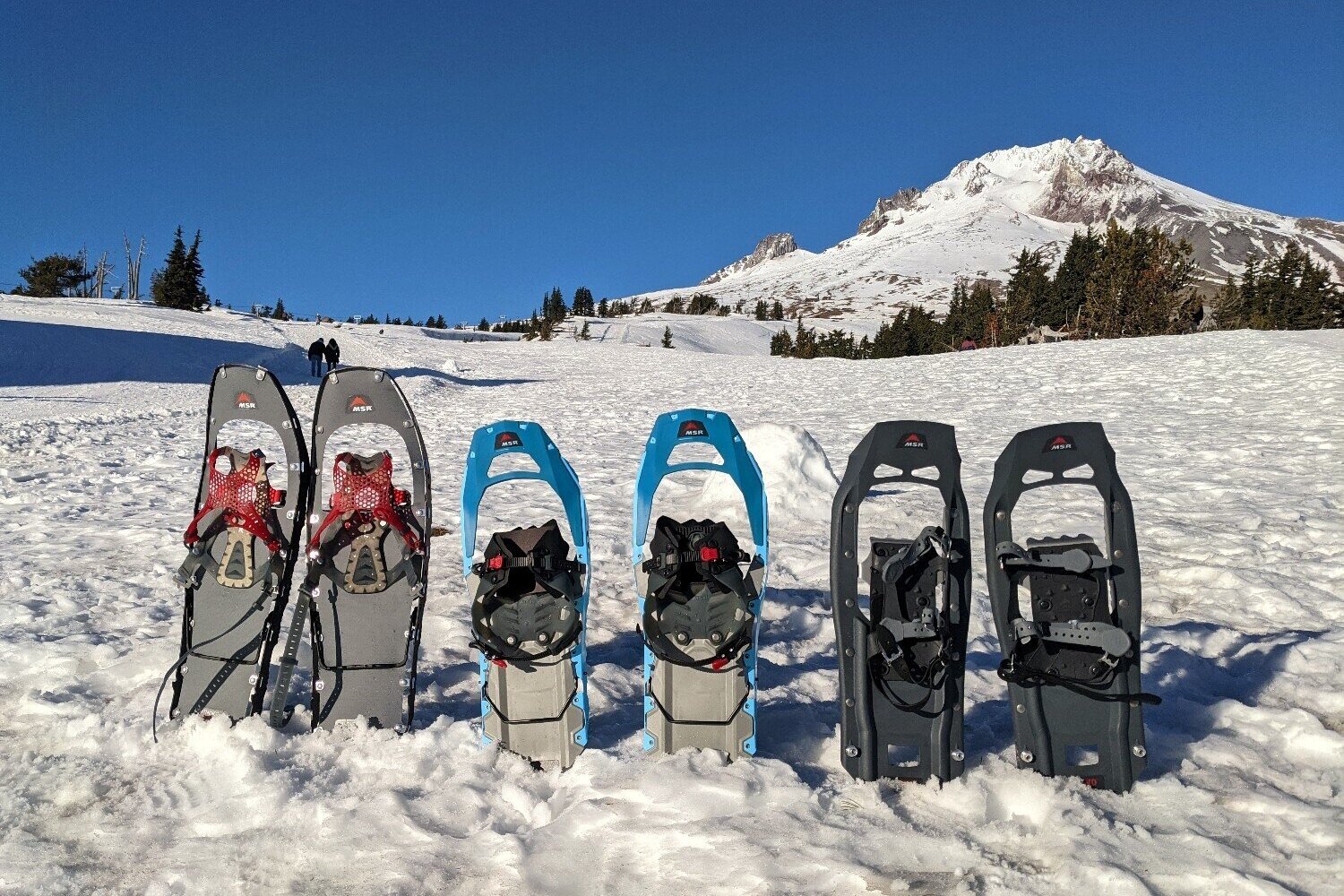
Snowshoes can make a difference whether you sink or swim on a winter hike. Snowshoes provide flotation and traction and are a huge aid for winter adventures. From the deep snow of Chugach Range to the icy slopes of Mt. Hood, we’ve taken our snowshoes out in every condition the mountains can throw at us.
No snowshoe hike is complete without the right winter gear to keep you warm and dry. See our winter hiking and camping tips and tip winter gear recommendations below:
Quick Picks for Snowshoes
Check out this quick list of our favorite snowshoes, or continue scrolling to see our full list with in-depth reviews.
Best Snowshoes Overall: MSR Lightning Ascent ($390) – Men’s / Women’s
Most Walkable Snowshoes: Tubbs Flex RDG ($200) – Men’s / Women’s
Versatile Snowshoes at a Good Value: MSR Revo Trail ($170) – Men’s / Women’s
Best Budget Snowshoes: MSR Evo Trail ($170)
Snowshoes made for off-trail travel: Tubbs Mountaineer ($220) – Men’s / Women’s
Value-priced for all experience levels & most types of terrain: Atlas Montane ($290) – Men’s / Women’s
Snowshoes that come with poles: Retrospect Drifter ($90)
Most comfortable snowshoes with great bindings: Tubbs Wayfinder ($200) – Men’s / Women’s
Most affordable snowshoes: XtremPro Outdoors Snowshoes ($50)
What’s New
- For those who put affordability above all else, the XtremPro Outdoors Snowshoes have an unbeatable price tag and come with a handy carrying case.
- For a versatile, and good-value snowshoe, look no further than the Tubbs Wayfinder (men’s / women’s).
- With this snowshoe’s namesake flexible deck, the Tubbs Flex RDG (men’s / women’s) is one of the most comfortable and walkable snowshoes we have tested.
- The Tubbs Mountaineer (men’s / women’s) is a sturdy snowshoe built for flotation in off-trail travel.
- The Retrospec Drifter is a budget snowshoe that still provides respectable features and versatility.
Snowshoe Overall Testing Scores
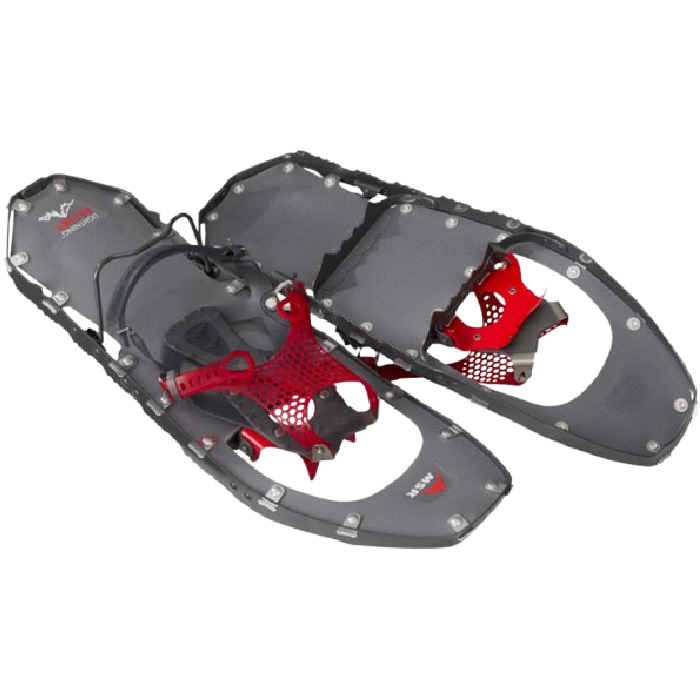
MSR Lightning Ascent
Best Snowshoes Overall
CleverHiker Rating: 4.8/5
Price: $390
Weight (Pair): 4 lb. 5 oz.(25 in.)
Length: 22”, 25”, or 30”; optional 5” tails
Materials: Aluminum/TPU Coated Nylon
Pros
- Good traction
- Good flotation
- Lightweight
- Heel lifts
- Secure bindings
Cons
- Expensive
- Clunky on packed trails
MSR’s Lightning Ascent snowshoes (men’s / women’s) is a top choice for winter recreators who demand the best performance in challenging, off-trail conditions. Designed for backcountry adventures, these snowshoes excel in both flotation and traction, making them perfect for deep snow and steep slopes. The lightweight aluminum frame and flexible nylon deck ensure high flotation. The aggressive traction system provides unmatched grip on icy, uneven terrain.
One of the standout features is the robust traction design. Claw-style crampons underfoot and serrated teeth along the edges of the frame ensure secure footing while climbing or descending steep terrain. This toothy bite provides confidence on both uphill and downhill slopes. Traction bars under the deck and teeth around the perimeter of the frame are handy for traversing across sloped surfaces. The design is unmatched when it comes to stability.
The MSR Lightning Ascent’s large surface area and flexible deck offer exceptional flotation in deep, unsupportive snow, although breakable crust conditions can sometimes challenge their performance. Heel risers are another key feature. They make steep climbs easier by reducing calf strain and can be quickly adjusted using a ski pole.
However, these snowshoes are not without their drawbacks. The aggressive traction system can make walking on packed or firm snow cumbersome. Also, the binding system can take some time to adjust, especially with gloves on. Despite these minor inconveniences, the MSR Lightning Ascent remains a top contender for those seeking durable, high-performance snowshoes that excel in tough, deep snow. If you’re ready to tackle challenging winter landscapes, these snowshoes can take on whatever the backcountry throws your way.
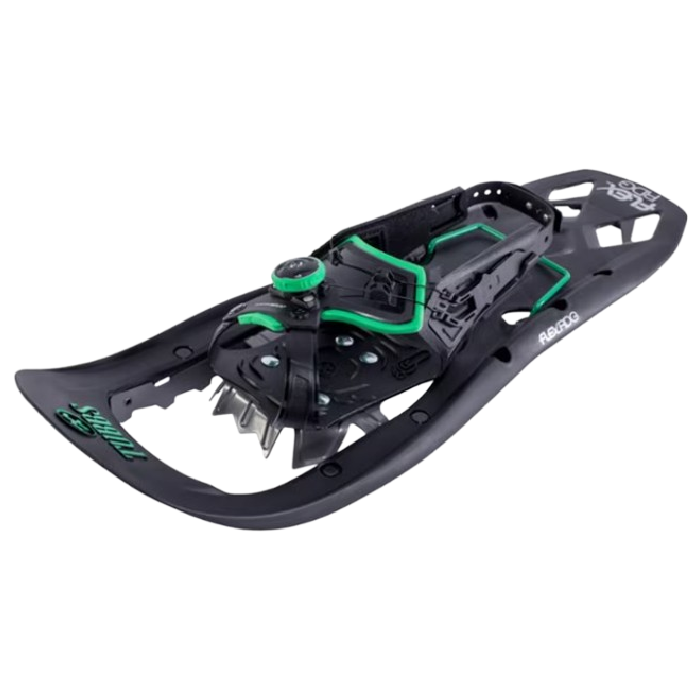
Tubbs Flex RDG
Most Walkable Snowshoes
CleverHiker Rating: 4.7/5
Price: $200
Weight (Pair): 3 lb. 14 oz.(24 in.)
Length: 24”, 28”
Materials: Powder Coated Steel/Polypropylene
Pros
- Easy to walk in
- Heel lifts
- Easy to use boa bindings
- Lightweight
- Great traction
Cons
- Less flotation in deep snow
The Tubbs Flex RDG (men’s / women’s)is a versatile and lightweight snowshoe designed for those seeking ease of movement across varied winter terrain. This snowshoe offers excellent walkability thanks to its flexible decking. The flexible decking bends with each step, reducing the cumbersome clomping common with traditional snowshoes. This feature is particularly beneficial on downhill descents, where the tail flexes with every stride for smoother movement. The narrow shape of the deck ensures a natural stance, providing comfort during long walks.
Built for traction, the Flex RDG features dual parallel traction rails made of powder-coated steel. These rails, combined with small claws under the forefoot, provide a reliable grip on variable snow conditions, from packed powder to loose sugary snow, to powder slopes and icy faces. However, its flotation capabilities suffer due to its narrower width and flexible deck that bends upwards, making it less ideal for deep or wet snow.
This model also boasts a user-friendly binding system with Boa technology. The design makes securely attaching them a cinch, and micro-adjustments are quick and easy. Although the heel riser is stiff to deploy, the additional support on uphill climbs is well worth it. A little chap-stick on the hinge of the heel riser helps with this
No snowshoe can totally defy gravity and avoid the clunk of a technical piece of footwear. Even with the reduced flotation in dense snow and a slight binding rattle, the Tubbs Flex RDG is a great option for winter adventurers who value versatility, ease of use, and great traction across mixed terrain.
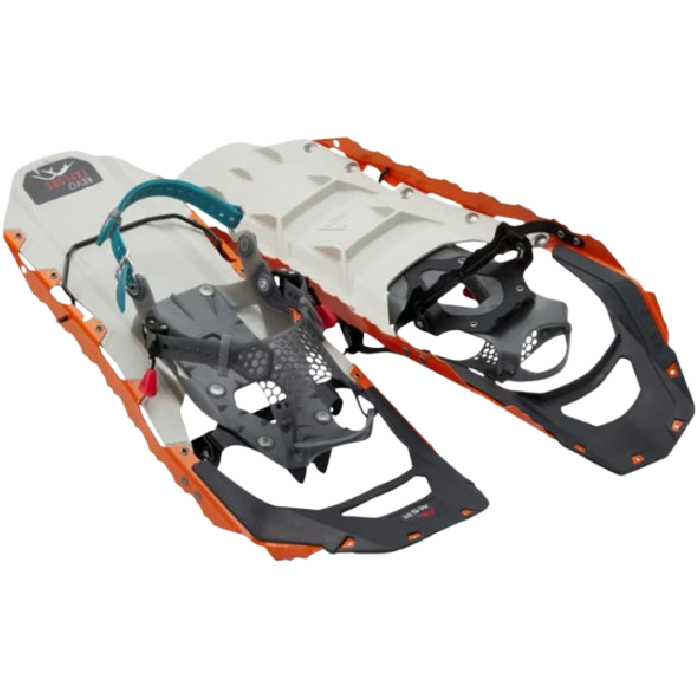
MSR Revo Explore
Versatile Snowshoes at a Good Value
CleverHiker Rating: 4.6/5
Price: $270
Weight (Pair): 4 lb. 4 oz.(22 in.)
Length: 22” or 25”; optional 5” tails
Materials: Martensetic steel
Pros
- Option to lengthen tails
- Shape helps maintain a natural gait
- Heel lifts
Cons
- Less flotation in deep snow
- Small teeth on traction claws
The MSR Revo Explore (men’s / women’s) is perfect for anyone seeking a lightweight, durable snowshoe that excels in many settings. With a robust build and advanced features, these snowshoes offer a perfect balance of performance and convenience. Serrated teeth around the frame provide excellent traction, steep slopes, and icy conditions. The front points and a vertical traction bar ensure a secure grip on both climbs and descents.
While the Revo Explore performs well across multiple snow surfaces and settings, its flotation capabilities are limited. The open tips with minimal decking reduce flotation in deep snow, causing the front of the snowshoes to sink more than the rear. Though they perform well in mixed conditions, the lack of flotation in powdery, untracked snow makes them less suitable for deep snow adventures. Adding MSR’s Revo Modular Flotation Tails increases flotation.
MSR’s Paradigm Binding system replaces traditional ratchet straps with a secure, easy-to-adjust rubber mesh. This binding ensures a snug fit and is easy to tighten and loosen even with gloves on. The heel risers provide added comfort during uphill climbs.
Though they can feel a bit stiff and clunky on packed trails due to their rigid structure, the Revo Explore is a reliable and versatile snowshoe. If you’re seeking durability, traction, and ease of use, it’s a great all-around choice.
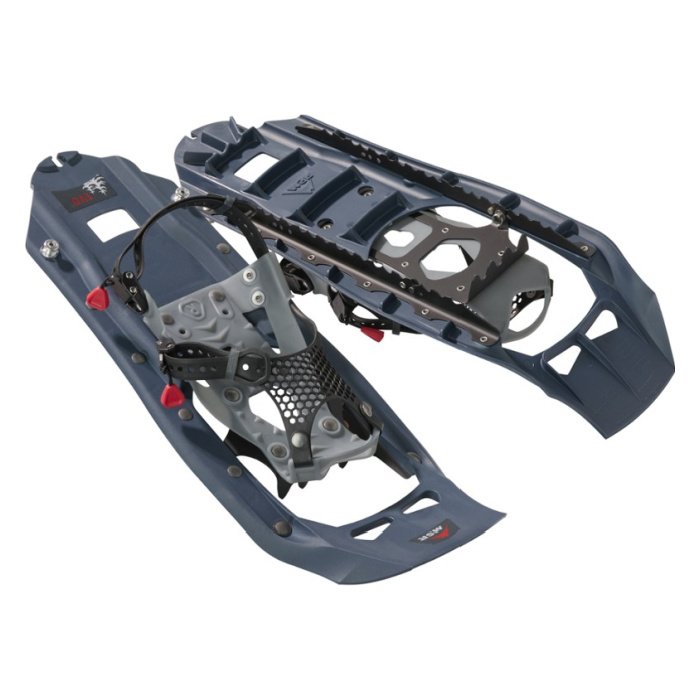
MSR Evo Trail
Best Budget Snowshoes
CleverHiker Rating: 4.6/5
Price: $170
Weight (Pair): 3 lb. 10 oz.
Length: 22”; optional 6” tails
Materials: Martensetic Steel/Polypropylene
Pros
- Affordable
- Good value
- Option to lengthen with tails
- Lightweight
- Good traction
Cons
- Only one size
- Less flotation than some
The MSR Evo Trail snowshoes offer an excellent combination of stability, comfort, and ease of use, making them an ideal choice for both beginners and seasoned winter hikers alike. Designed for moderate terrain and packed snow, these lightweight snowshoes deliver impressive traction with dual parallel traction rails and molded fins on the underside of the decking. The stiff plastic decking ensures durability and moderate flotation, though they perform best on packed trails and in less deep snow.
One of the standout features of the Evo Trail is its user-friendly binding system. Two straps easily tighten the binding to your boot. A large release lever makes putting on and removing the snowshoes a breeze, even while wearing gloves. While these snowshoes lack a heel riser for steeper inclines, their overall performance is best suited for flat to rolling terrain. The 22-inch size and relatively low surface area offer good walkability. However, larger snowshoes may be needed for deep powder or off-trail adventures.
The MSR Evo Trails offer great value at a competitive price. This option combines the performance of more expensive models with a more accessible price point. While they may not be the best option for extreme off-trail conditions, their durability, ease of use, and excellent traction make them ideal for most winter hikes.
Full Review: MSR Evo Trail

Tubbs Mountaineer
Snowshoes Made For Off-Trail Travel
CleverHiker Rating: 4.2/5
Price: $280
Weight (Pair): 4 lb. 14 oz.(25 in.)
Length: 21″, 25”, 30”, 36″
Materials: Aluminum, Nytex nylon
Pros
- Good traction
- Good flotation
- Heel lifts
Cons
- Heavy
- Expensive
The Tubbs Mountaineer (men’s / women’s) is for adventurers seeking to conquer deep snow and rugged terrain. Designed with durability and performance in mind, it combines a sturdy aluminum tube frame with flexible nylon decking to deliver exceptional flotation and resilience in off-trail conditions. Whether navigating breakable crust or ascending steep slopes, this snowshoe offers reliable support and traction.
A highlight of the Mountaineer is its impressive carbon steel crampons. Featuring Tubbs’ Anaconda crampon design with eight sharp teeth in the midfoot for secure uphill travel, kicking steps is a breeze. Rear-facing teeth in the heel provide excellent grip for descents. This aggressive traction system ensures confidence in variable terrain.
The Mountaineer’s ergonomic design supports a natural stride, with a slightly rockered profile that promotes a smooth gait. Its slightly raised tails also ease downhill travel. The wide frame floats in deep powder, though the weight and bulk may feel cumbersome on packed trails or a long trek.
The snowshoe’s ActiveFit 2.0 binding simplifies entry and exit with dual straps connected by a rubberized release system. The binding’s design primarily tightens across the foot’s bridge, which may cause discomfort and uneven pressure, particularly for smaller boots.
The Tubbs Mountaineer is a premium option for backcountry explorers seeking reliable performance. Its robust flotation, outstanding traction, and rugged build make it ideal for deep snow and steep terrain.
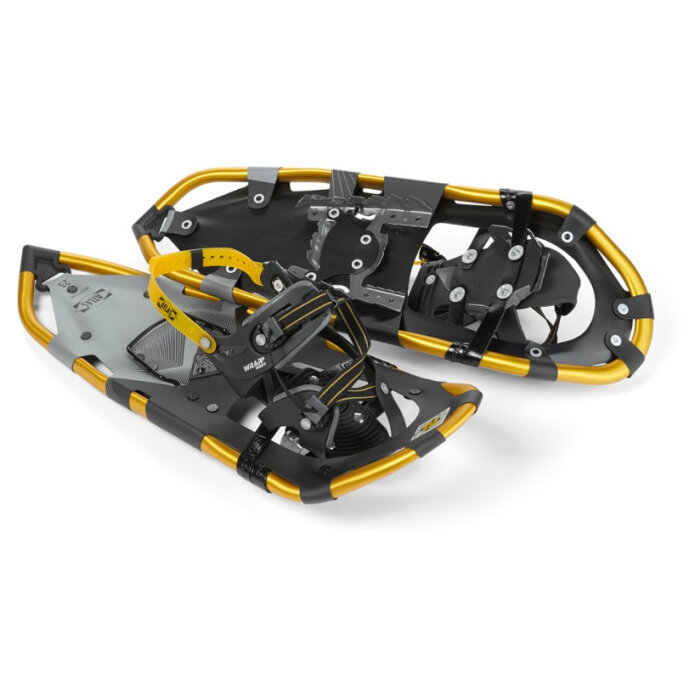
Atlas Montane
Value-priced Snowshoe for all Experience Levels & Most Types of Terrain
CleverHiker Rating: 4.2/5
Price: $250
Weight (Pair): 4 lb. 4 oz.(30 in.)
Length: 23″, 25”, 27″, 30”, 35”
Materials: Aluminum/polymer
Pros
- Good flotation
- Good traction
- Bindings work well for narrow feet
Cons
- Expensive
- Long binding straps
The Atlas Montane (men’s / women’s) snowshoe is a gate-opener for winter enthusiasts looking to venture into deep snow and mountainous terrain. Built with a sturdy aluminum frame and flexible polymer decking, it excels in providing flotation, traction, and comfort for backcountry exploration.
The Montane’s wide design ensures outstanding flotation, making it an excellent choice for breaking trails through untracked powder. Its flexible decking conforms to the snow surface, enhancing support and stability. This snowshoe’s aggressive traction system features steel teeth beneath the binding and heel and toothed rails for a secure grip on icy or uneven terrain. These features make it adept at handling steep ascents and challenging descents.
The unique rubberized strap pivot system aids walkability by adding a slight rebound to each step. While this provides comfort and helps the snowshoe’s tail snap back, it slightly limits the range of motion. Its wide profile may require a slightly adjusted stance, and long binding straps can occasionally get in the way.
With an intuitive and durable binding system designed for narrower boots, the Montane is easy to use even with gloves. Its included heel riser reduces fatigue on uphill climbs, making it a versatile tool for various winter terrains. The Atlas Montane is perfect for those seeking a traditional, durable snowshoe with modern enhancements that will keep you far away from post holes and safely gripped to the slope.
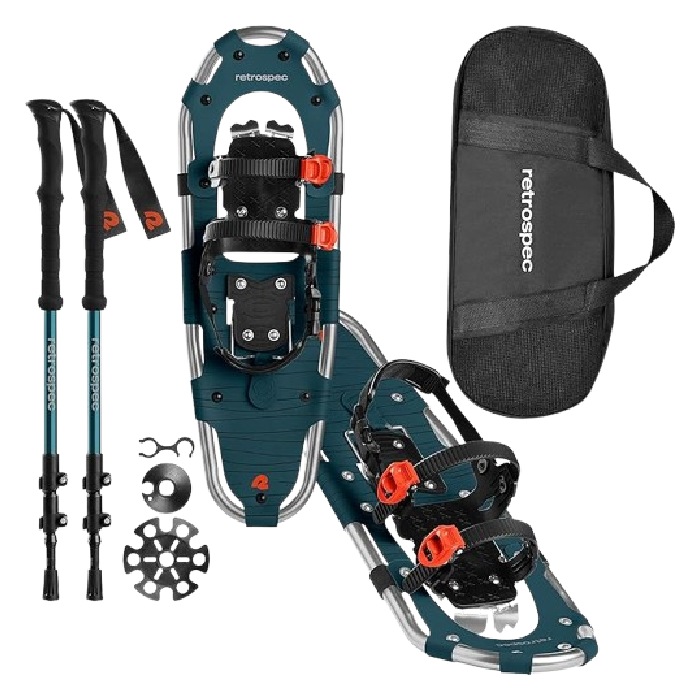
Retrospec Drifter
Snowshoes that Come with Poles
CleverHiker Rating: 4.0/5
Price: $90
Weight (Pair): 4 lb. 3 oz.(25 in.)
Length: 21″, 25”, 30”
Materials: Aluminum/Plastic
Pros
- Lightweight
- Easy to use
- Affordable
- Heel risers
Cons
- Low durability
- Bindings don't tighten as securely as some
- Low flotation
The Retrospec Drifter is an excellent choice for beginners or casual snowshoers looking for an affordable, easy-to-use option for light winter adventures. Performing best on packed trails and rolling terrain, the Drifter is a dependable pair of entry-level snowshoes.
Built with a lightweight aluminum frame and plastic decking, this snowshoe makes for a stable and easy-movement snowshoeing experience. Its narrower shape allows for a natural gait. Two simple plastic ratchet straps secure the midfoot, while a reinforced webbing strap cradles the heel. Adjustments are intuitive and can be made quickly, even with gloves on. The easily deployed heel riser reduces strain on the calves during uphill climbs.
While the Drifter performs well on mellow trails, it has some limitations. Its narrow frame and minimal surface area struggle in deep snow, and the plastic decking can become brittle in colder temperatures. Traction is adequate for moderate slopes, but we wouldn’t trust them for steep, icy terrain. The bindings, though user-friendly, can feel less secure on smaller boots, and the long straps can trip you. The Retrospec Drifter is perfect for those new to snowshoeing or seeking a budget-friendly option for occasional outings. While it lacks the durability and advanced features of premium models, its accessible design and lightweight build make it the perfect snowshoe for the first-timer.
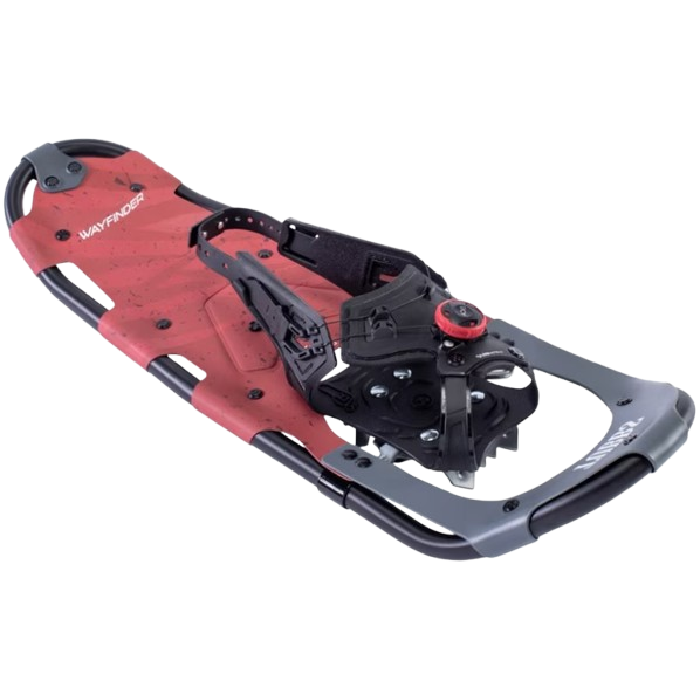
Tubbs Wayfinder
Comfortable Snowshoes with Great Bindings
CleverHiker Rating: 4.4/5
Price: $200
Weight (Pair): 3 lb. 6 oz.(25 in.)
Length: 21″, 25”, 30”, 36″
Materials: Aluminum, Nytex nylon
Pros
- Option to lengthen tails
- Shape helps maintain a natural gait
- Heel lifts
Cons
- Less flotation in deep snow
- Small teeth on traction claws
The Tubbs Wayfinder snowshoe (Men’s / Women’s) is an excellent choice for entry-level adventurers seeking versatility, comfort, and ease of use without breaking the bank. Featuring a lightweight aluminum frame and durable Nytex nylon decking, the Wayfinder is designed for rolling trails and light powder conditions. Its tapered, teardrop-like design promotes a natural stride, while the rockered profile ensures smooth movement across various terrains.
A standout feature is the innovative boa binding system, which simplifies securing and adjusting the snowshoes. With a quick twist of the dial, you can achieve a snug fit that stays secure on your foot. Micro-adjustments and loosening are quick and easy, all while wearing gloves.
The Wayfinder loves packed trails and gentle inclines. They are less suited for steep or icy slopes due to their limited traction. The short traction points provide adequate grip on moderate terrain but can struggle on more challenging surfaces. Additionally, flotation is best in moderate snow depths less than twelve inches deep, as the tapered design offers less surface area than some competitors.
The Tubbs Wayfinder balances high-quality materials with a user-friendly design, making it a top choice for casual outings. Whether you’re exploring groomed trails or venturing into light powder, this snowshoe delivers comfort and convenience for beginners and recreational users alike.
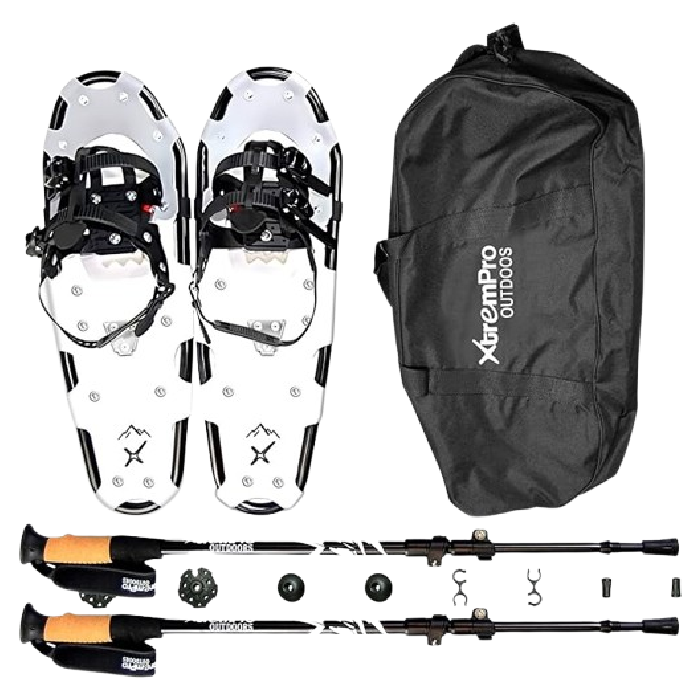
XtremPro Outdoors Snowshoes
Most Affordable Snowshoes
CleverHiker Rating: 3.8/5
Price: $50
Weight (Pair): 4 lb. 14 oz.(25 in.)
Length: 17″, 21″, 25”, 30”, 36″
Materials: Aluminum/plastic
Pros
- Good traction
- Good flotation
- Heel lifts
Cons
- Heavy
- Expensive
The XtremPro Outdoors Snowshoes offer a budget-friendly entry into winter hiking. They are ideal for beginners or those seeking an affordable way to explore snowy trails with a little more ease than post-holing around with soggy boots. With a lightweight aluminum frame and simple plastic decking, these snowshoes prioritize accessibility and straightforward functionality for casual outings.
Thanks to their narrow design, the XtremPro Outdoors Snowshoes are comfortable to walk in and require no awkward adjustments to your gait. Their compact size works well on packed trails or shallow snow, though their flotation struggles in deeper powder. Teeth traction is sufficient for gentle terrain, but less effective on steep or icy slopes. The ExtremPro Outdoors Snowshoes are adequate for flat or rolling trails but are unsuitable for more challenging adventures.
The snowshoes feature ratchet bindings similar to those found on snowboard bindings. While they accommodate various boot sizes, the rigid plastic straps can press uncomfortably on the foot and ankle during extended use. Long, unsecured binding tails and limited toe pivot range impact overall comfort and performance. These snowshoes are an entry-level option for light trail use but are not the most durable or versatile of our favorites. If you’re new to snowshoeing or need an inexpensive option for occasional outings, the XtremPro Outdoors Snowshoes deliver functional performance at an unbeatable price.
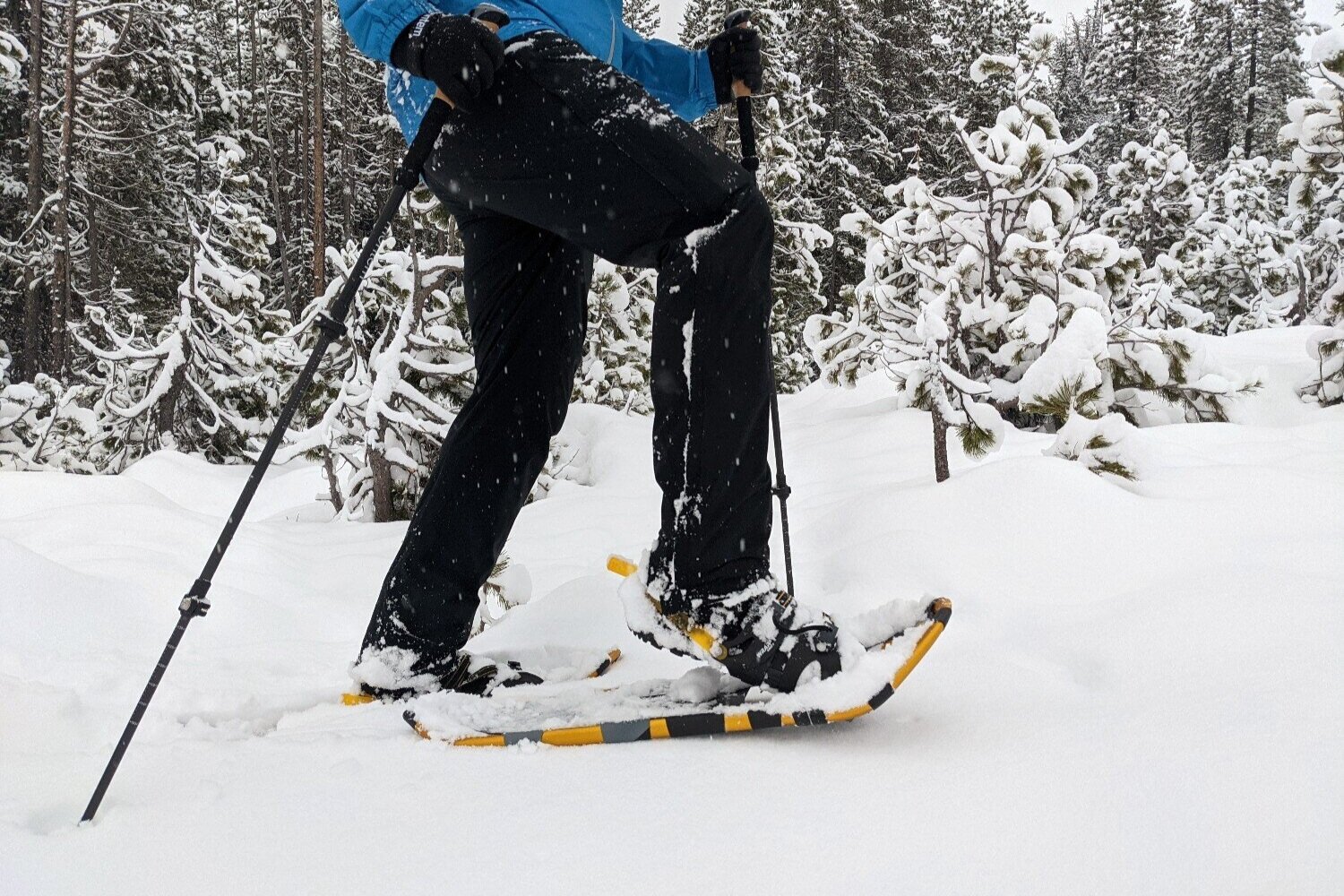
Product Comparison Table
| oSort | Product | CleverHiker Rating | Price | Weight (Pair) | Length | Materials | Flotation | Traction | Walkability | Ease of Use | 0 |
MSR Lightning Ascent Men's Women's |
4.8/5 | $390 | 4 lb. 5 oz. (25 in.) | 22”, 25”, or 30”; optional 5” tails | Aluminum/TPU Coated Nylon | 4.7 | 4.9 | 4.6 | 4.5 | 1 |
Tubbs Flex RDG Men's Women's |
4.7/5 | $200 | 3 lb. 14 oz. (24 in.) | 24”, 28” | Powder Coated Steel/Polypropylene | 4.4 | 4.5 | 4.7 | 4.7 | 2 |
MSR Revo Explore Men's Women's |
4.6/5 | $270 | 4 lb. 4 oz. (22 in.) | 22” or 25”; optional 5” tails | Martensetic steel | 4.5 | 4.8 | 4.6 | 4.5 | 3 |
MSR Evo Trail View at REI View at Amazon |
4.6/5 | $170 | 3 lb. 10 oz. | 22”; optional 6” tails | Martensetic Steel/Polypropylene | 4.4 | 4.6 | 4.6 | 4.6 | 4 |
Tubbs Mountaineer Men's Women's |
4.2/5 | $280 | 4 lb. 14 oz. (25 in.) | 21″, 25”, 30”, 36″ | Aluminum, Nytex nylon | 4.5 | 4.2 | 4.3 | 4.3 | 5 |
Atlas Montane View Men's View Women's |
4.2/5 | $250 | 4 lb. 4 oz. (30 in.) | 23″, 25”, 27″, 30”, 35” | Aluminum/polymer | 4.5 | 4.2 | 4.3 | 4.2 | 6 |
Retrospec Drifter View at Amazon |
4.0/5 | $90 | 4 lb. 3 oz. (25 in.) | 21″, 25”, 30” | Aluminum/Plastic | 3.9 | 4.1 | 4.2 | 4.2 | 7 |
Tubbs Wayfinder Men's Women's |
4.4/5 | $200 | 3 lb. 6 oz. (25 in.) | 21″, 25”, 30”, 36″ | Aluminum, Nytex nylon | 4.3 | 3.8 | 4.7 | 4.7 | 8 |
XtremPro Outdoors Snowshoes View at Amazon View at Walmart |
3.8/5 | $50 | 4 lb. 14 oz. (25 in.) | 17″, 21″, 25”, 30”, 36″ | Aluminum/plastic | 3.9 | 3.8 | 4 | 3.8 |
|---|
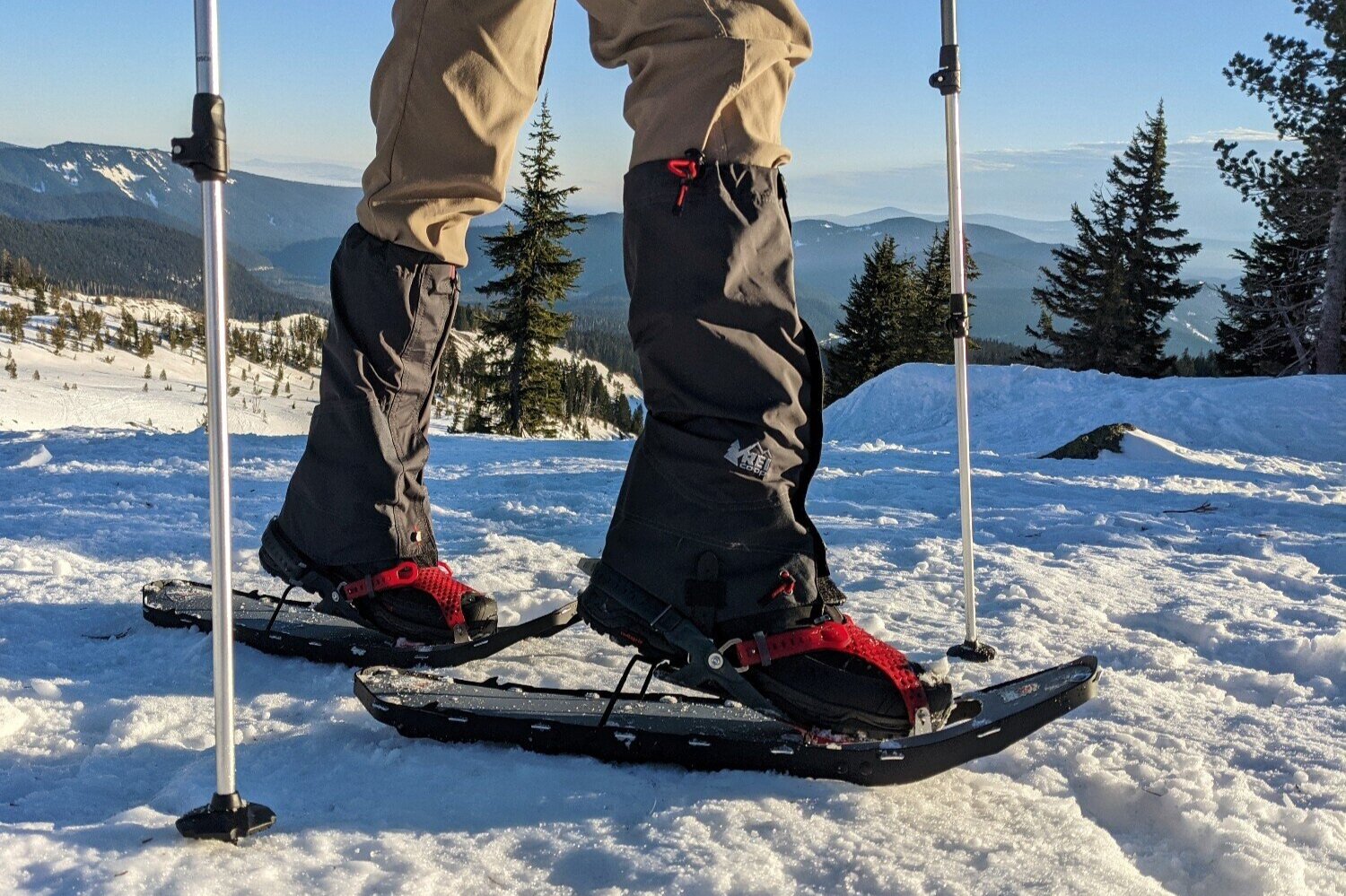
How We Test
FLOTATION
Flotation is the ability of the snowshoe to keep the wearer suspended in the snowpack without sinking too deeply. We test the flotation of snowshoes by doing side-by-side comparisons in a variety of conditions. From packed trail to powder to breakable crust, we take these snowshoes through every snow type we can find. By doing these tests side-by-side, we can get the best feel for which snowshoes excel in which conditions.

TRACTION
When venturing out onto snowy trails and mountainsides, encountering loose and slicked surfaces is common. We test the traction of each snowshoe by taking them up, down, and across various slope angles and snow surfaces. We evaluate any loss of control and test snowshoes side by side to get comparative results. We finish by examining the traction system, (crampons, teeth, or rails), and analyzing them to determine in which conditions they work best.
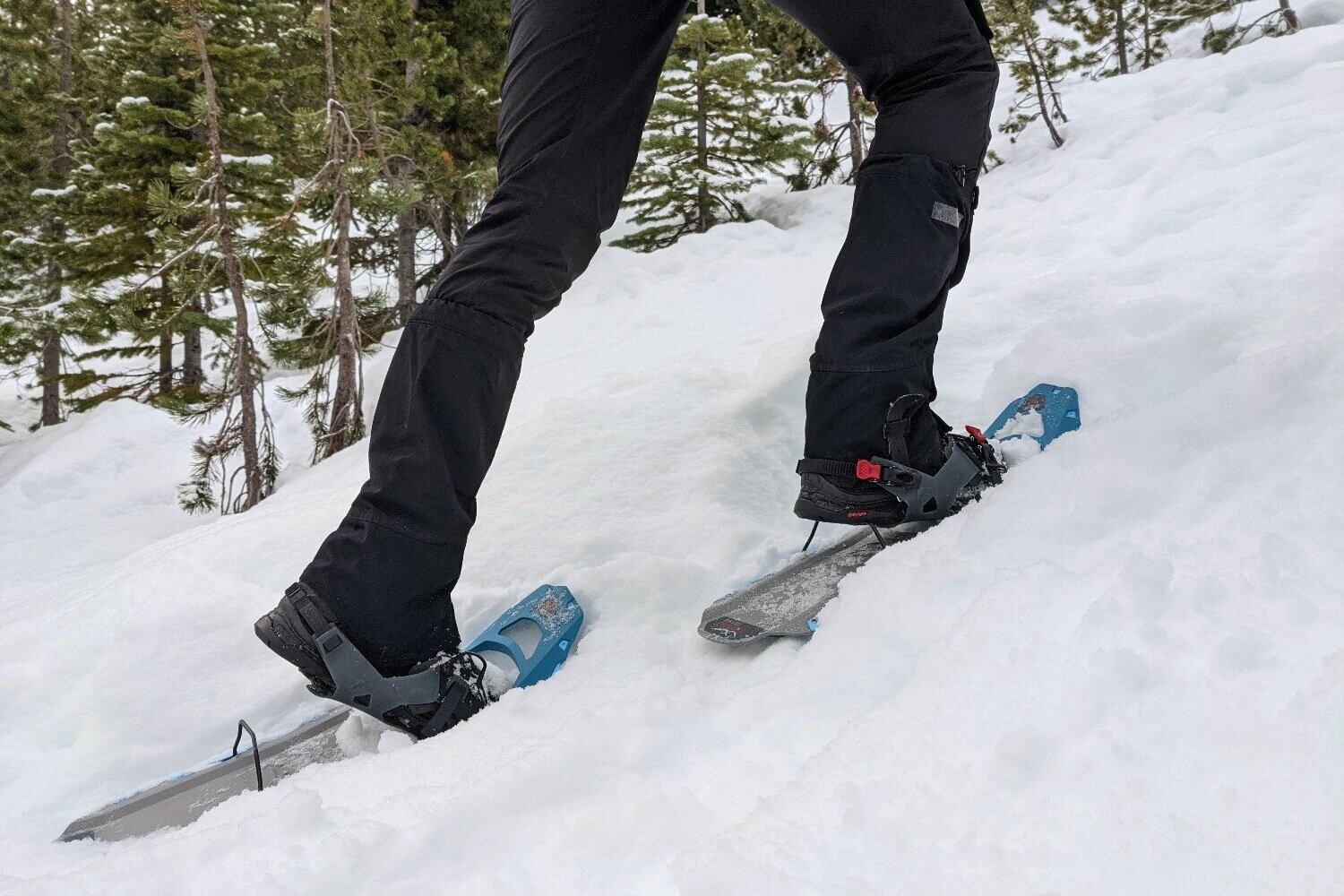
WALKABILITY
Walkability is just as it sounds: how easy is it to walk while wearing them? This encompasses features like the pivot system of the binding, the shape and dimensions of the snowshoe, as well as their weight and maneuverability. We spend hours hiking in each snowshoe to examine how their walkability impacts the user experience and what styles and systems allow for the most natural gait and stance.
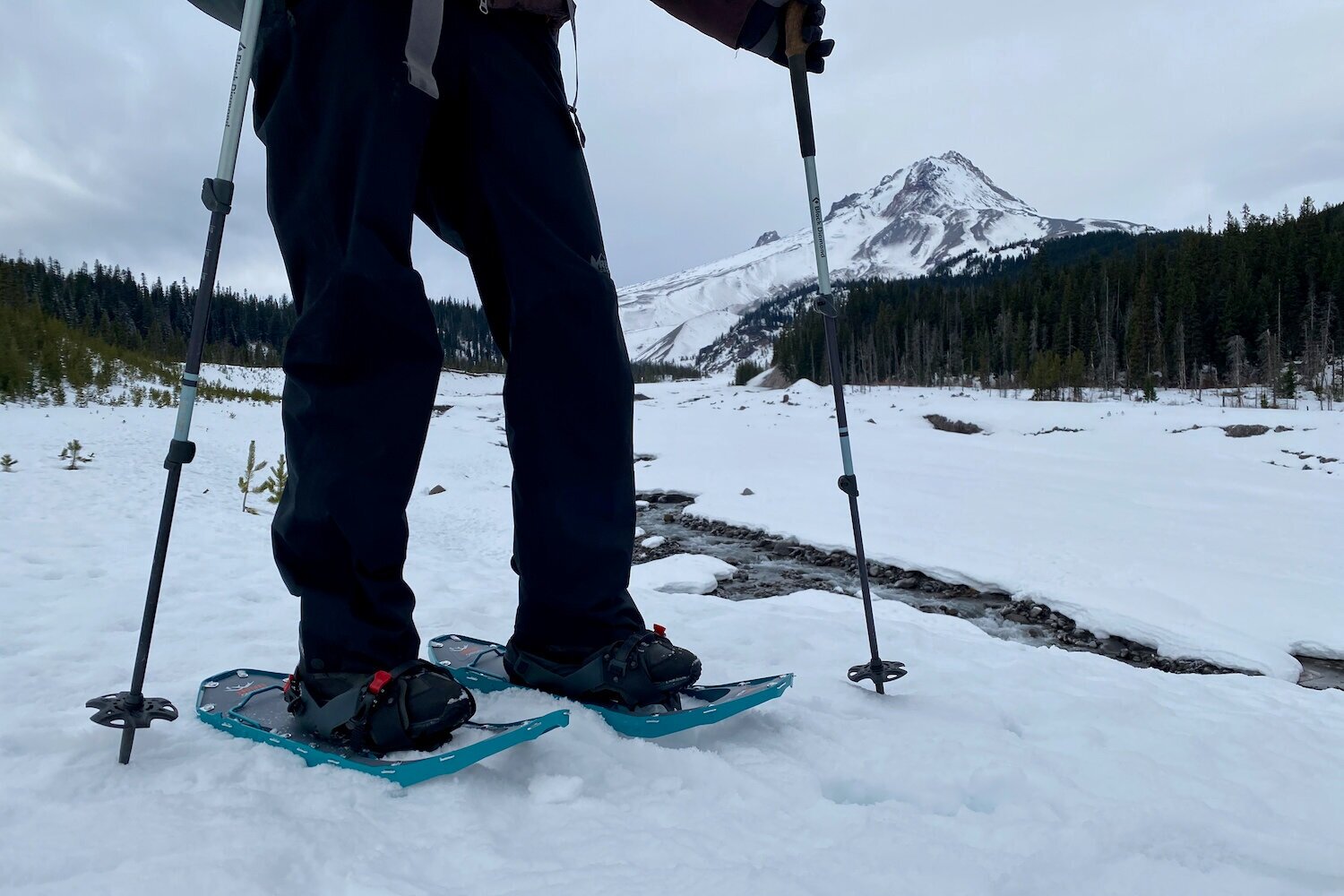
EASE OF USE
Ease of use is an all-encompassing category that seeks to test and define the usability of the snowshoe. This focuses on the bindings of the snowshoe but also includes other features like heel risers. We test these features with and without gloves to see how easy they are to use in cold temperatures when we want to limit exposure to the air. We evaluate the bindings for their comfort, adjustability, strength, and integrity.
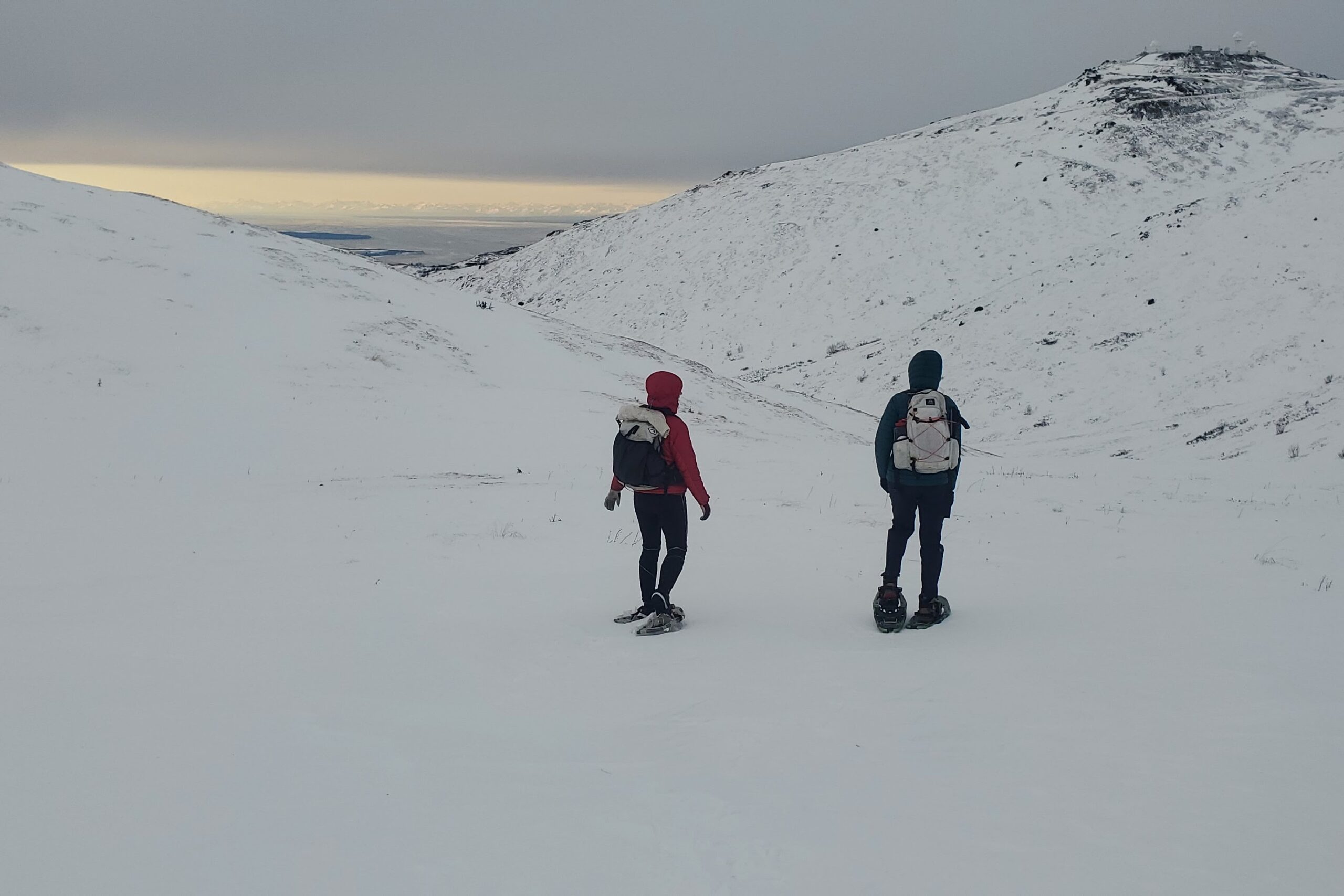
Why Trust CleverHiker?
We’ve hiked dozens of miles in every pair of snowshoes on this list and have brought them through every winter condition possible. From ice and slush to high alpine drifts and deep snow, every snowshoe in our lineup has withstood some of the harshest winter conditions.
Tested in Alaska by Gear Analyst, Miles Knotek, we take pride in our rigorous field testing process. Miles is a self-proclaimed winter lover who recreates outside year-round no matter the weather. His experience in backcountry travel, combined with a critical eye and methodical approach to testing brings you the best recommendations and analysis possible.
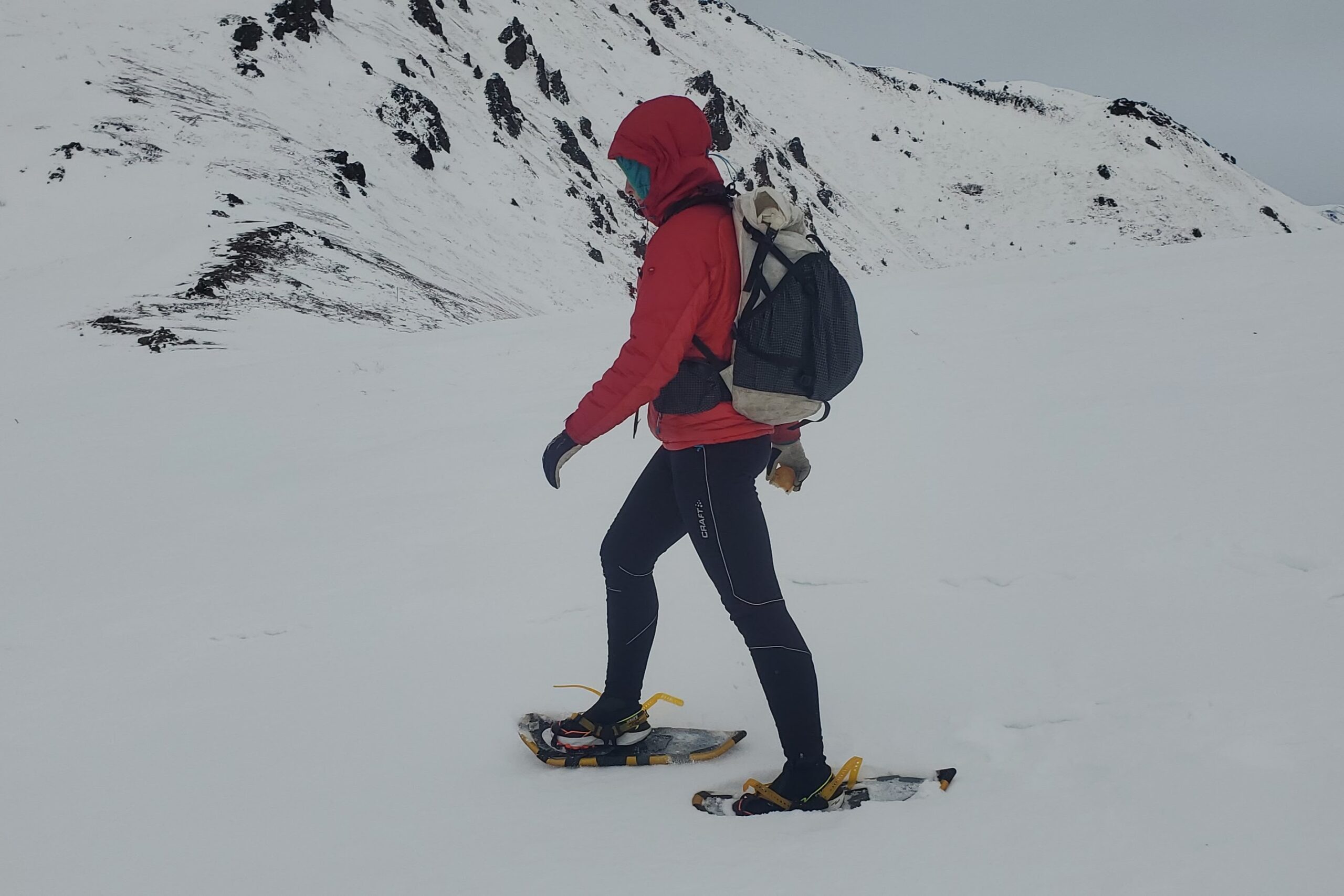
Analysis & Results
VALUE
If your number one consideration when choosing snowshoes is price, then it’s hard to beat either the Retrospec Drifter or the XtremPro Outdoors Snowshoes. These are both sold on Amazon for under $100 and are some of the least expensive snowshoes on the market. However, their low price comes with concessions in features, durability, and performance.
For the best combination of a reasonable price with excellent features, we recommend the MSR Evo Trail. With a reasonable price tag under $200, and widely available, it is an excellent snowshoe for the beginner or anyone looking to get the most out of their dollar. It has features of more expensive snowshoes like dual traction rails, single molded plastic, and an excellent binding. It makes a great quiver of one for most winter hikers.
FLOTATION
Throughout our testing, we listed flotation as the most important factor when assessing each snowshoe’s performance. A snowshoe’s number one priority is to keep the user suspended in the snow without sinking too deeply. Our lineup features a variety of snowshoes with different levels of flotation, but a few stand out. We loved how the MSR Lightning Ascent provided a large surface area and flexible decking. Extra float also comes from a longer overall length than our other favorites in this guide. The flexible decking cups the snow and stretches to contour the surface. We loved the snowshoes for venturing into deep snow.
In the traditional construction category of snowshoes, the tubular aluminum frame provides time-tested flotation. The Tubbs Mountaineer and Atlas Montane are both examples of this. With their wide platforms and sturdy decking woven between the frames, these options are most at home off-trail, setting their track.
TRACTION
There is nothing worse on a mountain hike than losing your footing, slipping backward, and having to regain those lost steps. Snowshoes provide traction through a variety of means: traction rails, crampons, teeth, or serration around the metal frame. It’s rare to hike the same type of snow all season, so the best snowshoes provide secure traction in a variety of snow types. With this in mind, the MSR Lighting Ascent and MSR Revo Explore are the clear winners.
Both feature an aluminum rail for the frame with an array of serrated teeth. This added traction is huge for slippery slopes and descending steep terrain. The front points on the Lightning Ascent’s crampons are especially impressive and were notable when kicking steps while climbing. Both snowshoes have vertical bars behind the midfoot that provide additional traction while descending, a crucial feature to eliminate sliding out on the tails.
WALKABILITY
When many people think of snowshoes, the feeling of awkwardly clomping along may come to mind. Our favorites on this gear guide have come a long way since the tennis racket-looking version hanging on a wall of a log cabin. Walkability is an important consideration to keep you going for miles without added exertion or fighting against the weight of the snowshoes. Thanks to some impressive engineering and design, many modern snowshoes feel like an extension of the foot and greatly enhance the walking experience.
We reach for the Tubbs Flex RDG and the Tubbs Wayfinder for the most walkable snowshoes. The Tubbs Flex RDG, in particular, stood out for its unique construction. True to its name, the deck of the Flex RDG bends and flexes with each step. This all but eliminates the clomping so common in other snowshoes. This was especially noticeable when walking downhill where the tails bent to accommodate each downhill step. The Wayfinder, while constructed with traditional tubular aluminum and woven decking, features some of the strongest rocker we have seen. Rocker is the upward bend of a snowshoe from tips to tail that resembles a U-shape. This allows a rolling feel from the heel to the toe and eliminates the flopping of flat and stiff snowshoes.
EASE OF USE
When testing each snowshoe, we carefully evaluated how easy it was to use each snowshoe. This applied to bindings, features like heel risers, and the product’s overall design. For bindings, those with boas lead the way for ease of use. The Tubbs Flex RDG and Tubbs Wayfinder are equipped with technology. We love boas for their quick and easy adjustment, ability to dial in a precise fit, and the ability to use them while wearing gloves.
Also earning top spots for ease of use are the MSR Lightning Ascent and MSR Evo Trail. Both feature near-identical bindings that allow the user to set the midfoot adjustments once, and slip in and out with ease. A simple strap is tightened across the heel to keep the foot secure. Both the Flex RDG and Lightning Ascent come equipped with heel risers, whereas the Evo Trail and Wayfinder forego this feature. These are easily deployed up or stowed down with the flick of a pole and greatly reduce the strain on calves while tackling a long uphill climb.
How to Choose Snowshoes
CONSTRUCTION STYLE
Those who have been in the snowshoe world for long enough have seen a long evolution in the style and construction of snowshoes. Early snowshoes consisted of wood, animal hide, and sinew. Modern snowshoes now use advanced materials and construction techniques to maximize stability and lightweight performance.
The most instantly recognizable and classic snowshoe style is the tubular aluminum frame. This rounded frame wraps around the perimeter of the snowshoe and is connected with a semi-flexible decking to provide flotation. While time-tested and durable, this construction style lacks the traction and performance of others on the market. It is best for floating through deep powder but is not effective on icy or steep terrain where grip is mandatory.
Most modern snowshoes are formed from a single piece of molded plastic or an aluminum frame in a vertical orientation with teeth for added traction. Single-piece snowshoes are simple, lightweight, and easy to use but sometimes lack the durability and traction of framed snowshoes. Aluminum frame snowshoes set the bar for traction with vertical teeth around the perimeter of the snowshoes. This style provides the best combination of flexible decking for flotation, as well as extreme grip for traction on ice slopes.
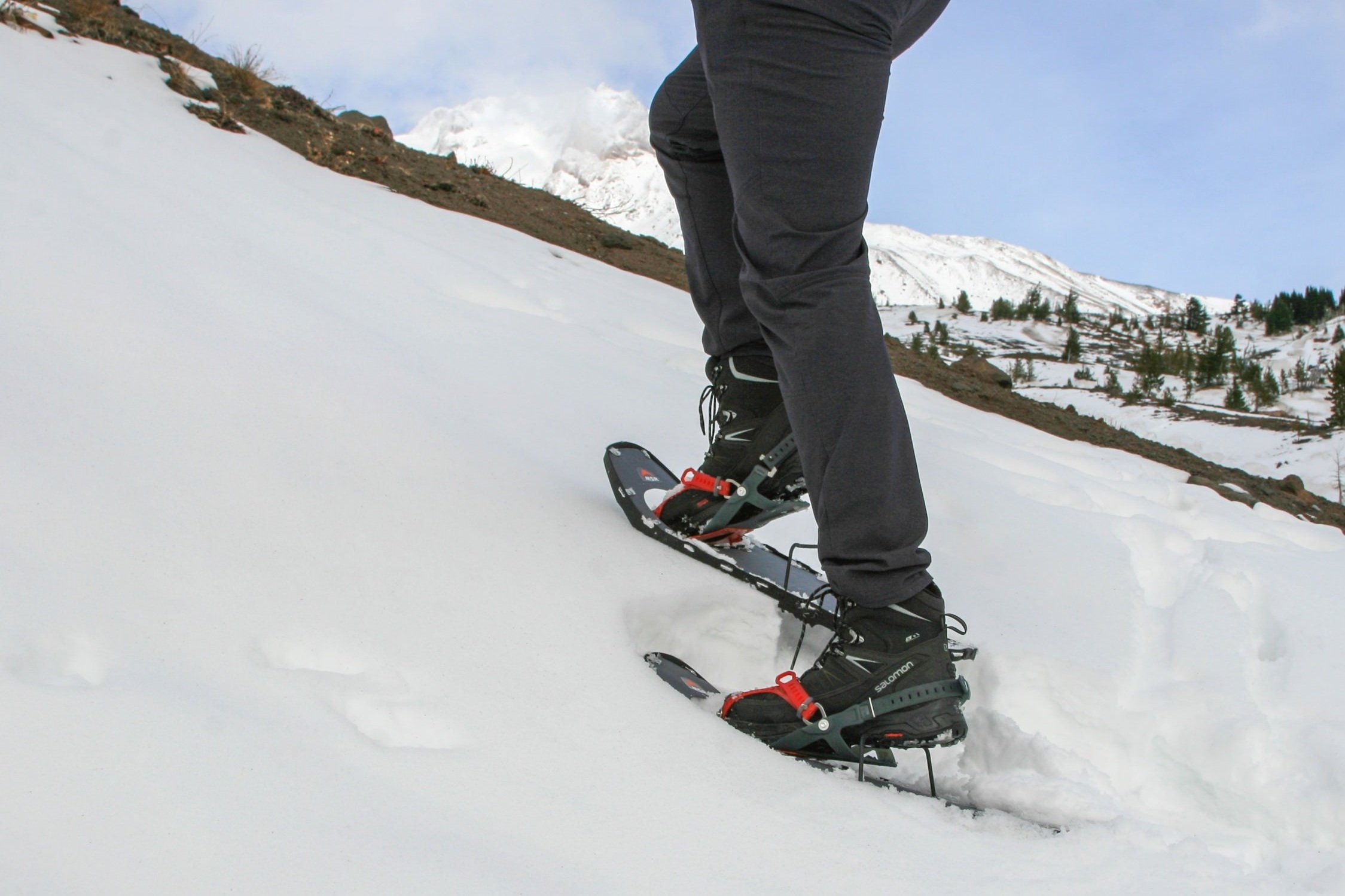
INTENDED USE
When choosing which snowshoes to purchase, it’s important to consider where and when you will take them. Do you prefer to stick to the groomed or packed trail? Do you plan to venture into deep snow and variable terrain? Much like many other pieces of outdoor gear, snowshoes are designed with specific conditions and uses in mind. It’s important to match the snowshoes to the appropriate activity for the most enjoyable experience possible.
For use on groomed trails and packed surfaces, you may opt for a lighter snowshoe with less traction in favor of more walkability and a smoother ride. Smaller snowshoes with a rockered profile or flexible material make for a more comfortable snowshoe on firmer surfaces. For those venturing into deep snow and variable conditions, consider heavier snowshoes with more flotation and traction. While these may feel clunky on packed trails, they excel off-trail.
Sizing is also a consideration. Smaller snowshoes are more maneuverable and lighter. If you are a lighter person, a smaller snowshoe will work better for you. Longer snowshoes accommodate a wider range of weights and provide more flotation. However, they can be more cumbersome and more challenging to maneuver in tight spaces.
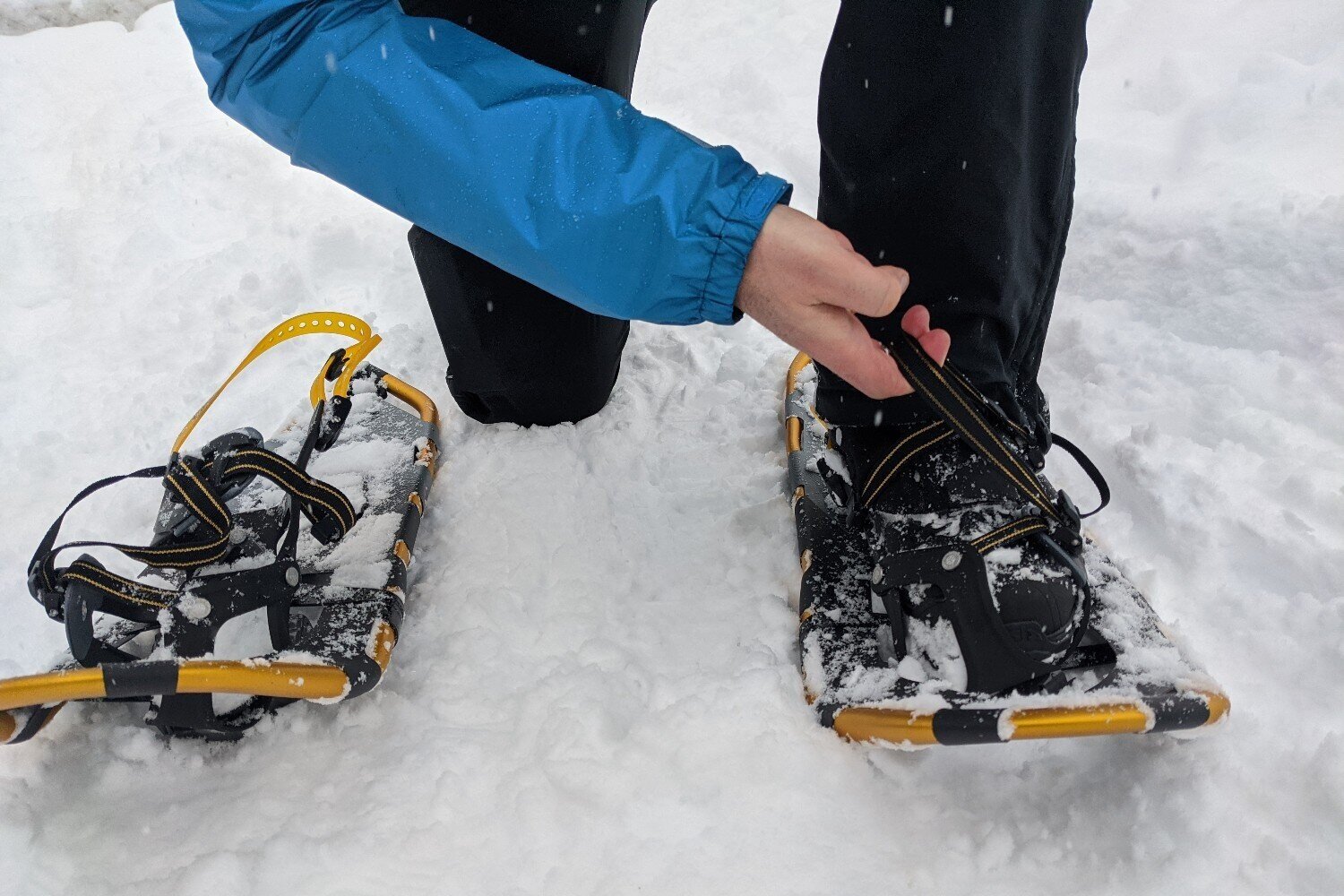
BINDINGS
In today’s snowshoe market, it’s easy to get bound up in all the different binding styles. Bindings range from simple locking straps to ratchets, rubberized mesh, to boa systems. Each has its own unique set of advantages and drawbacks.
Simple strap systems are simple to use and durable but often sacrifice comfort and security for ease of use. The strap’s excess tails can also flop out and trip you, so they need to be tucked in.
Ratchet systems are straightforward and will be familiar to anyone who has ever strapped on a snowboard. The main drawback is that they can be uncomfortable on the foot. With only two straps going across the midfoot, they can press uncomfortably on the bridge of the foot. Tightening these down is necessary to provide a secure fit but sacrifices comfort.
Rubberized mesh across the midfoot is an excellent design. It is both comfortable and secure, with a strap on either side that attaches it to the rest of the binding. The biggest drawback is that it can be challenging to fit large-volume boots into. Their lower profile is comfortable and lightweight but can be difficult to slip on.
Lastly, boa systems are the most technologically advanced option on the market. Simply pop down the dial and twist it to tighten, or pop it up to loosen. Boas allow for adjustability and are easy to use with gloves on. However, the thin cables can be easily severed if you aren’t careful around sharp edges. Once broken, boas are hard to fix and lose any ability to retain tension.
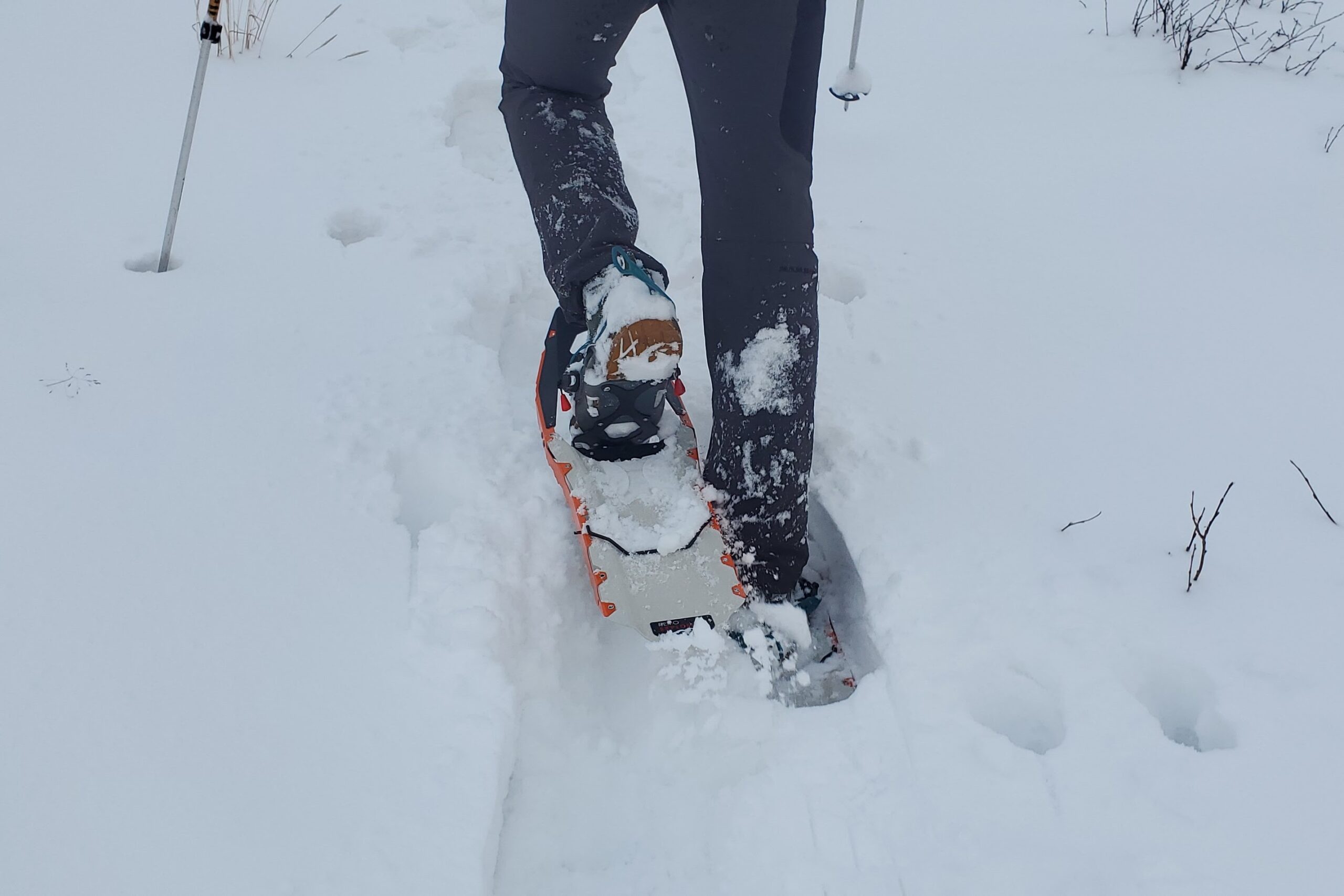
Conclusion
At Cleverhiker, we work to bring you the best selection of gear rear-round. We hike miles in the snow and ice and spend days outside in all weather. When the temperatures drop and the snow piles up, we strap on our snowshoes and head out to bring you the most comprehensive analysis possible. We own all the gear we test and stand by every recommendation we make after thorough field testing.
